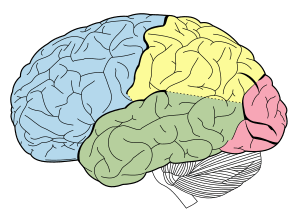Paratonia
Paratonia is the inability to relax muscles during muscle tone assessment. There are two types of paratonia: oppositional and facilitatory. Oppositional paratonia ("gegenhalten") occurs when subjects involuntarily resist to passive movements,[1] while facilitatory paratonia ("mitgehen") occurs when subjects involuntary assist passive movements.[2][3][4]

Both types of paratonia have been associated with cognitive impairment or mental disorders, particularly in relation to frontal lobe dysfunction.[1][5][6][7][8][9] Paratonia is frequently encountered in clinical practice.[10]
Paratonia can be assessed with rating scales during clinical examination. Paratonia scale is a semi-quantitative score to rate the amount of oppositional and facilitatory paratonia separately.[5] Kral modified procedure is a more objective semi-quantitative rating of upper limb facilitatory paratonia easily applicable while patients are seated.[5] The Paratonia Assessment Instrument (PAI) was also used in a physiotherapic setting for the assessment of oppositional paratonia.[11]
In 2017 facilitatory and oppositional paratonia have been assessed with surface electromyography, allowing a quantitative measure and better characterization of paratonia.[12] Recording paratonia with electromyography on elbow flexor and extensors during repetitive continuous or discontinuous elbow movements may help distinguish paratonia from other forms of altered muscle tone. Both facilitatory and oppositional paratonia increase during continuous flexion and extension movements, moreover, oppositional paratonia increases with movement velocity.[12] Spasticity also is velocity-dependent,[13] but, differently from oppositional paratonia, if repeatedly elicited decreases instead of increasing.[14] Conversely, parkinsonian rigidity is independent from movement velocity and probably also from movement repetition.[15]
See also
References
- Dupré, E (1910). "Débilité mentale et débilité motrice associées" [Mental disability and associated motor impairment]. Revue Neurologique (Paris) (in French). 20: 54–56.
- Kral, VA (1949). "Ueber eine iterative Bewegunsstörung bei Stirnhirnläsionen". Monatsschrift für Psychiatrie und Neurologie (in German). 118 (5): 257–272. doi:10.1159/000148085.
- Mumenthaler, M (1990). Neurology. Stuttgart: Thieme.
- Fogel, Barry S. (2015). Psychiatric Care of the Medical Patient. Oxford University Press. p. 45. ISBN 9780190226299.
- Beversdorf, D. Q.; Heilman, K. M. (1998-10-01). "Facilitory paratonia and frontal lobe functioning". Neurology. 51 (4): 968–971. doi:10.1212/wnl.51.4.968. ISSN 0028-3878. PMID 9781514.
- Kurlan, R.; Richard, I. H.; Papka, M.; Marshall, F. (2000-01-01). "Movement disorders in Alzheimer's disease: more rigidity of definitions is needed". Movement Disorders. 15 (1): 24–29. doi:10.1002/1531-8257(200001)15:1<24::aid-mds1006>3.0.co;2-x. ISSN 0885-3185. PMID 10634238.
- Bennett, Hayley P.; Corbett, Alastair J.; Gaden, Susan; Grayson, David A.; Kril, Jillian J.; Broe, G. Anthony (2002-12-01). "Subcortical vascular disease and functional decline: a 6-year predictor study". Journal of the American Geriatrics Society. 50 (12): 1969–1977. doi:10.1046/j.1532-5415.2002.50608.x. ISSN 0002-8614. PMID 12473008.
- Damasceno, Alfredo; Delicio, Adriane M.; Mazo, Daniel F. C.; Zullo, João F. D.; Scherer, Patricia; Ng, Ronny T. Y.; Damasceno, Benito P. (2005-09-01). "Primitive reflexes and cognitive function". Arquivos de Neuro-Psiquiatria. 63 (3A): 577–582. doi:10.1590/S0004-282X2005000400004. ISSN 0004-282X. PMID 16172703.
- Vahia, Ipsit; Cohen, Carl I.; Prehogan, Alla; Memon, Zaitoon (2007). "Prevalence and Impact of Paratonia in Alzheimer Disease in a Multiracial Sample". The American Journal of Geriatric Psychiatry. 15 (4): 351–353. doi:10.1097/jgp.0b013e31802ea907. PMID 17384318.
- Hobbelen, Johannes S. M.; Tan, Frans E. S.; Verhey, Frans R. J.; Koopmans, Raymond T. C. M.; Bie, Rob A. de (2011-09-01). "Prevalence, incidence and risk factors of paratonia in patients with dementia: a one-year follow-up study". International Psychogeriatrics. 23 (7): 1051–1060. doi:10.1017/S1041610210002449. ISSN 1741-203X. PMID 21269542.
- Hobbelen, Johannes S. M.; Koopmans, Raymond T. C. M.; Verhey, Frans R. J.; Habraken, Kitty M.; Bie, Rob A. de (2008-08-01). "Diagnosing paratonia in the demented elderly: reliability and validity of the Paratonia Assessment Instrument (PAI)". International Psychogeriatrics. 20 (4): 840–852. doi:10.1017/S1041610207006424. ISSN 1741-203X. PMID 18177542.
- Marinelli, Lucio; Mori, Laura; Pardini, Matteo; Beversdorf, David; Cocito, Leonardo; Currà, Antonio; Fattapposta, Francesco; Ghilardi, Maria Felice; Abbruzzese, Giovanni (2016-12-20). "Electromyographic assessment of paratonia". Experimental Brain Research. 235 (3): 949–956. doi:10.1007/s00221-016-4854-7. ISSN 0014-4819. PMID 27999892.
- Trompetto, Carlo; Marinelli, Lucio; Mori, Laura; Pelosin, Elisa; Currà, Antonio; Molfetta, Luigi; Abbruzzese, Giovanni (2014-10-30). "Pathophysiology of Spasticity: Implications for Neurorehabilitation". BioMed Research International. 2014: 354906. doi:10.1155/2014/354906. ISSN 2314-6133. PMC 4229996. PMID 25530960.
- AL-Zamil, Z.M.; Hassan, N.; Hassan, W. (2016-09-04). "Reduction of Elbow Flexor and Extensor Spasticity Following Muscle Stretch". Neurorehabilitation and Neural Repair. 9 (3): 161–165. doi:10.1177/154596839500900305.
- Meara, R. J.; Cody, F. W. (1992-08-01). "Relationship between electromyographic activity and clinically assessed rigidity studied at the wrist joint in Parkinson's disease". Brain: A Journal of Neurology. 115 ( Pt 4) (4): 1167–1180. doi:10.1093/brain/115.4.1167. ISSN 0006-8950. PMID 1393509.